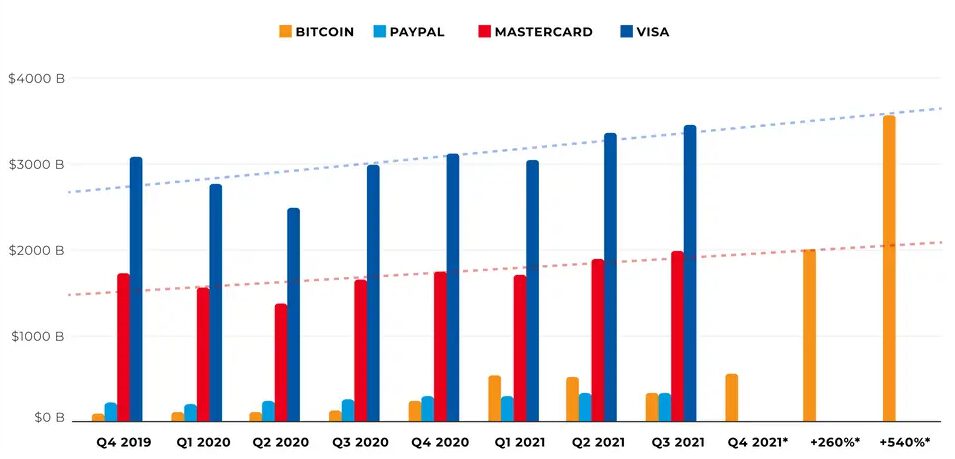The mainstream adoption and acceptance of Bitcoin over the past couple of years has translated into good numbers. The cryptocurrency network reportedly surpassed the leading payment platform PayPal, by conducting 62% more transactions in terms of dollar value, as per a report by Blockdata.
Although this was a significant milestone to achieve, the real test for Bitcoin lies ahead, in conquering payment giants such as MasterCard and Visa. In 2021, the Bitcoin network processed about $489 billion per quarter. On the other hand, PayPal processed $302 billion per quarter, while Mastercard and Visa were significantly ahead at $1.8 trillion and $3.2 trillion per quarter, the report noted.
The above chart shows that a significant feat is yet to be achieved by Bitcoin to match the level of established payment providers. However, Blockdata suggests it isn’t impossible after all. In this context, the report noted,
“It’s impressive how Bitcoin, as a 12-year-old decentralized network, is 27% of the way in terms of one metric (volume processed) compared to Mastercard, a company founded in 1966.”
It also noted that their significantly different use cases should also be taken into account. Since Bitcoin is essentially a “saving technology” while the rest are “spending technologies.” In any case, the report highlighted a few factors that could help bring Bitcoin to the levels of processing on the two established payment networks.
Among them, the first was the average amount of Bitcoin sent per transaction. Albeit, the network would have to scale 260% to process an equivalent volume to the Mastercard network on a daily basis, and 540% for Visa. The report noted that rather than noting a rise in the number of BTC being transferred, the tremendous increase in price over the past year has caused a significant fall in the same.
The price of Bitcoin itself could also contribute to expansion, however, this too would require a similar growth percentage. While Bitcoin reaching these price points such as $245k and $435k is virtually impossible to determine, the report noted that it could take place by 2026, if this year’s growth metric is considered.
The most significant, however, is the number of transactions handled by the Bitcoin network. Its base layer handled around 25 million transactions per quarter over the past year. Thus amounting to 280k transactions per day.
Contrastingly, Mastercard processed an average of 33 billion transactions per quarter over the past year, 366 million per day. Further, Visa processed an average of 53.7 billion transactions per quarter over the past year, or 597 million per day.
This stark difference comes from the scalability issues faced by the Bitcoin blockchain, which Layer 2 solutions are aiming to solve. Carrying out transactions off-chain, the Lightning Network has already seen explosive adoption within months of release. While it is difficult to monitor traffic on this Layer, estimates have suggested that 663k transactions were carried out in September 2021 alone.
The report also suggested that the growth of the protocol’s user base to one million, which is just 1% of the total BTC users, could almost double the Bitcoin’s network’s daily throughput.
In fact, a State of a Lightning report released by Arcane has estimated that the Lightning Network would grow to 800 million users by 2030.


